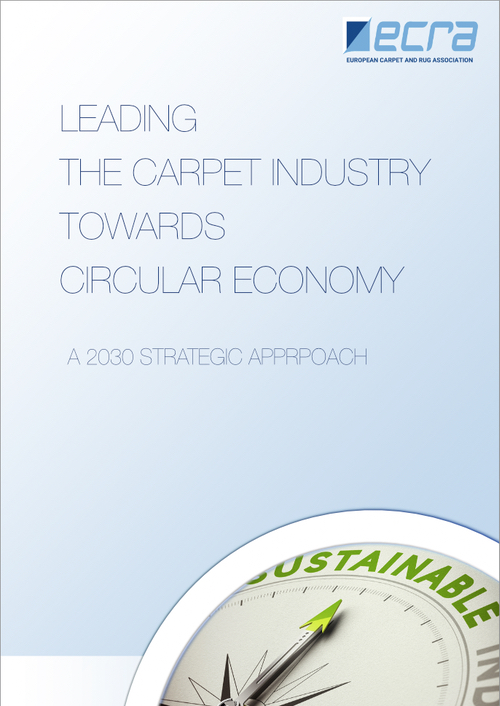Circular Economy
Circular Economy
LEADING THE CARPET INDUSTRY TOWARDS CIRCULAR ECONMY
– A 2030 ACTION PLAN –
Executive Summary
Carpets come in a wide range of different types, including loose laid rugs, wall-to-wall floor coverings, carpet tiles, exhibition and event carpet and are suitable for both residential and commercial applications. They are also important in the automotive, outdoor sports and landscaping sectors.
In recent years, although carpet recycling has seen a growth in some innovative end use applications, it is still low overall as approximately 37% of carpet waste goes to energy recovery. However, the combination of recycling and energy recovery is still an important step forward as it has diverted much of the waste from landfill.
When considering the waste streams for any type of floorcoverings, post-consumer remains the most important followed respectively by post-installation and post-industrial. The collection route of carpet differs from that of textiles. The collection point for any carpet to be recycled is either at the time of installation of the new carpet by the installer, or by collection from the site by an appointed recycler. As there is little demand for carpet to be reused, there is huge potential for the materials to be recycled.
There are limited numbers of independent recycling schemes in the EU with a margin for growth in numbers and size providing adequate measures and incentives are undertaken. Retrospectively, carpet recycling schemes have failed due to the economics for commercial viability being reliant on high value end of life applications. This determining factor cannot be ignored in any given future solution or initiative.
Fortunately, today, we see a positive evolution towards an increase potential for new applications for carpet recycling particularly regarding fibre extraction, contaminant reduction and purification of output, coupled with the drive for recycling being designed into the products, ie designed for end of life. Overall, this leads to a promising increase in circularity of products and materials which then leads to new high value end use applications.
With the new circular economy action plan in play, the focus should now be on improving technologies and facilities to maximise the value of the end product, as well as continuing to increase the volumes of carpets available for recycling.
An important stepping stone is to address the post-consumer waste stream for carpet to ensure appropriate collection and sorting schemes so that the product’s potential value is maintained. This means that carpets must be kept dry, uncontaminated, and sortable. The same principles would apply to any manufacturer’s B2B or B2C take back schemes to recover carpet when new products are delivered.
The new EU circular economy action plan needs to provide the necessary economies of scale so that the carpet industry can transition to the new model. There needs to be market based incentives to encourage suppliers to develop take back services and develop valuable end of life markets.
Removing barriers is a prerequisite to any success story for circularity of the products. These may range from legislative barriers through adaptation to the circular economy and climate change objectives, to technological through increase R&D, innovation activities and up take, scaling up of ideas and prototypes. And definitely also includes the possible costs for design of collection schemes that have been a source for failures in the past.
Digitalisation can also play an important role particularly with regard to value chain management including the waste phase and product related information to facilitate sorting and recycling.
Environmental benefit derived from a circular economy in respect of climate change and management of natural resources can reduce the overall carbon footprint of products and processes and encourage sustainable consumption and production including diverting and reducing waste from landfill & incineration. This will also lead to a reduction in the chemical load by reducing the need for consumption.
Technological innovation along the value chain can contribute to improve the environmental performance of products enabling full circularity of materials and the uptake in the use of more recycled content and materials.
A transition to a full circular economy of the European carpet industry and closing the loop would require a shift from old practices, an adapted performance framework and strategic thinking in addressing key challenges.
The industry approach outlined herein for achieving full potential for circular economy by 2030 is an integrated approach, multidimensional, cross sectorial, value chain driven and economically viable to ensure a long-term stability and competitiveness in which economic growth, social cohesion and environmental protection go hand in hand and are mutually supporting.
In adopting the Circular Economy approach, the industry can take control of its future at the European and global levels by implementing initiatives for the entire life cycle of products, from design and manufacturing to consumption, reuse, recycling for a sustainable production and consumption, reduce carbon and material footprint, increase the circular material use rate, address the use and the presence of substances of very high concern in processes and products, restrict single-use carpets, target zero waste to landfill, mobilise the potential of digitalisation of product and process information, increase recycled plastic content, increase carpet waste prevention and reduction, support a better collection and sorting of carpet waste and contribute to the better management of natural resources including renewables ones.
The industry strategy is built on four key pillars:
- Robust shift to circular economy in a standardised way
- Ensure innovation is driving the change
- Make new technologies and circular materials a permanent feature of the future
- Increase sustainable and renewable products in the market, adhering to the circularity principles

